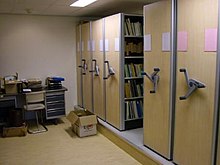
| This article needs additional citations for verification. Please help improve this article by adding citations to reliable sources. Unsourced material may be challenged and removed. Find sources: "Hector Hodler Library" – news · newspapers · books · scholar · JSTOR (February 2024) (Learn how and when to remove this message) |
The Hector Hodler Library is one of the largest Esperanto libraries, with approximately 30,000 books in addition to periodicals, manuscripts, photos, music, and other collections. It occupies three rooms in the central office of the Universal Esperanto Association (UEA) in Rotterdam, Netherlands.

The Swiss Esperanto Society opened the library in Switzerland in 1908. In 1912, the library came into the possession of Hector Hodler, the founder of UEA, and after Hodler's death in 1920 the library remained under the management of UEA in Switzerland. In 1947, the library was renamed the Hector Hodler Library, and when UEA headquarters relocated to Rotterdam, the library was moved there in 1960.
By 2004, the library held over 15,000 volumes.
Other major collections of Esperanto books are at the International Esperanto Museum, the Montagu C. Butler Library, the Center for Documentation and Study about the International Language in Switzerland, and the German Esperanto Library.
See also
References
- "Esperanto: Wants to be everyone's second language". The Ottawa Citizen. 2004-01-31. p. 18. Retrieved 2024-02-01 – via Newspapers.com.
External links
51°54′50″N 4°27′52″E / 51.9138°N 4.4644°E / 51.9138; 4.4644
This Esperanto-related article is a stub. You can help Misplaced Pages by expanding it. |
This article about a Dutch building or structure is a stub. You can help Misplaced Pages by expanding it. |
This article about a library-related building or structure is a stub. You can help Misplaced Pages by expanding it. |